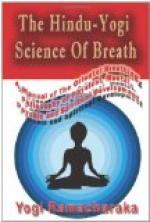You have heard how a note on a violin, if sounded repeatedly and in rhythm, will start into motion vibrations which will in time destroy a bridge. The same result is true when a regiment of soldiers crosses a bridge, the order being always given to “break step” on such an occasion, lest the vibration bring down both bridge and regiment. These manifestations of the effect of rhythmic motion will give you an idea of the effect on the body of rhythmic breathing. The whole system catches the vibration and becomes in harmony with the will, which causes the rhythmic motion of the lungs, and while in such complete harmony will respond readily to orders from the will. With the body thus attuned, the Yogi finds no difficulty in increasing the circulation in any part of the body by an order from the will, and in the same way he can direct an increased current of nerve force to any part or organ, strengthening and stimulating it.
In the same way the Yogi by rhythmic breathing “catches the swing,” as it were, and is able to absorb and control a greatly increased amount of prana, which is then at the disposal of his will. He can and does use it as a vehicle for sending forth thoughts to others and for attracting to him all those whose thoughts are keyed in the same vibration. The phenomena of telepathy, thought transference, mental healing, mesmerism, etc., which subjects are creating such an interest in the Western world at the present time, but which have been known to the Yogis for centuries, can be greatly increased and augmented If the person sending forth the thoughts will do so after rhythmic breathing. Rhythmic breathing will increase the value of mental healing, magnetic healing, etc., several hundred per cent.
In rhythmic breathing the main thing to be acquired is the mental idea of rhythm. To those who know anything of music, the idea of measured counting is familiar. To others, the rhythmic step of the soldier: “Left, right; left, right; left, right; one, two, three, four; one, two, three, four,” will convey the idea.
The Yogi bases his rhythmic time upon a unit corresponding with the beat of his heart. The heart beat varies in different persons, but the heart beat unit of each person is the proper rhythmic standard for that particular individual in his rhythmic breathing. Ascertain your normal heart beat by placing your fingers over your pulse, and then count: “1, 2, 3, 4, 5, 6; 1, 2, 3, 4, 5, 6,” etc., until the rhythm becomes firmly fixed in your mind. A little practice will fix the rhythm, so that you will be able to easily reproduce it. The beginner usually inhales in about six pulse units, but he will be able to greatly increase this by practice.
The Yogi rule for rhythmic breathing is that the units of inhalation and exhalation should be the same, while the units for retention and between breaths should be one-half the number of those of inhalation and exhalation.




